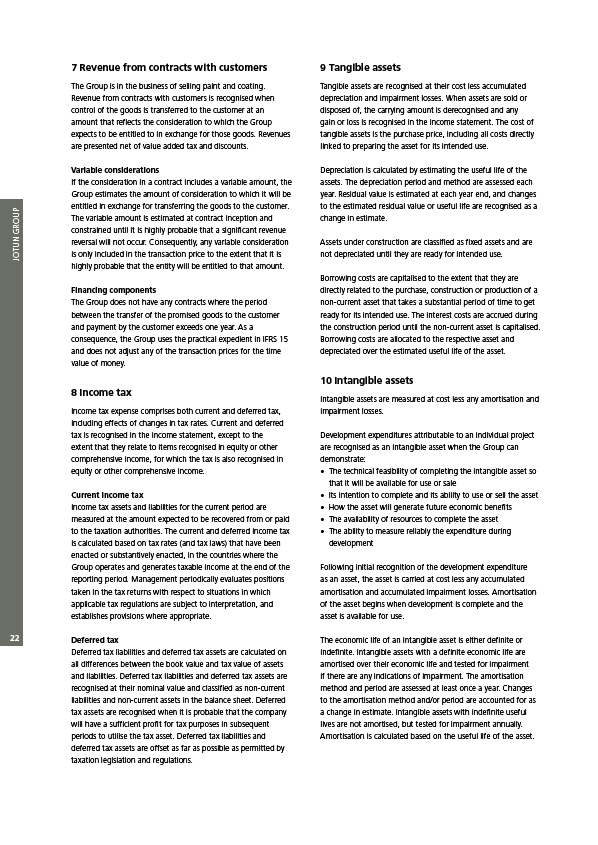
JOTUN GROUP
22
7 Revenue from contracts with customers
The Group is in the business of selling paint and coating.
Revenue from contracts with customers is recognised when
control of the goods is transferred to the customer at an
amount that reflects the consideration to which the Group
expects to be entitled to in exchange for those goods. Revenues
are presented net of value added tax and discounts.
Variable considerations
If the consideration in a contract includes a variable amount, the
Group estimates the amount of consideration to which it will be
entitled in exchange for transferring the goods to the customer.
The variable amount is estimated at contract inception and
constrained until it is highly probable that a significant revenue
reversal will not occur. Consequently, any variable consideration
is only included in the transaction price to the extent that it is
highly probable that the entity will be entitled to that amount.
Financing components
The Group does not have any contracts where the period
between the transfer of the promised goods to the customer
and payment by the customer exceeds one year. As a
consequence, the Group uses the practical expedient in IFRS 15
and does not adjust any of the transaction prices for the time
value of money.
8 Income tax
Income tax expense comprises both current and deferred tax,
including effects of changes in tax rates. Current and deferred
tax is recognised in the income statement, except to the
extent that they relate to items recognised in equity or other
comprehensive income, for which the tax is also recognised in
equity or other comprehensive income.
Current income tax
Income tax assets and liabilities for the current period are
measured at the amount expected to be recovered from or paid
to the taxation authorities. The current and deferred income tax
is calculated based on tax rates (and tax laws) that have been
enacted or substantively enacted, in the countries where the
Group operates and generates taxable income at the end of the
reporting period. Management periodically evaluates positions
taken in the tax returns with respect to situations in which
applicable tax regulations are subject to interpretation, and
establishes provisions where appropriate.
Deferred tax
Deferred tax liabilities and deferred tax assets are calculated on
all differences between the book value and tax value of assets
and liabilities. Deferred tax liabilities and deferred tax assets are
recognised at their nominal value and classified as non-current
liabilities and non-current assets in the balance sheet. Deferred
tax assets are recognised when it is probable that the company
will have a sufficient profit for tax purposes in subsequent
periods to utilise the tax asset. Deferred tax liabilities and
deferred tax assets are offset as far as possible as permitted by
taxation legislation and regulations.
9 Tangible assets
Tangible assets are recognised at their cost less accumulated
depreciation and impairment losses. When assets are sold or
disposed of, the carrying amount is derecognised and any
gain or loss is recognised in the income statement. The cost of
tangible assets is the purchase price, including all costs directly
linked to preparing the asset for its intended use.
Depreciation is calculated by estimating the useful life of the
assets. The depreciation period and method are assessed each
year. Residual value is estimated at each year end, and changes
to the estimated residual value or useful life are recognised as a
change in estimate.
Assets under construction are classified as fixed assets and are
not depreciated until they are ready for intended use.
Borrowing costs are capitalised to the extent that they are
directly related to the purchase, construction or production of a
non-current asset that takes a substantial period of time to get
ready for its intended use. The interest costs are accrued during
the construction period until the non-current asset is capitalised.
Borrowing costs are allocated to the respective asset and
depreciated over the estimated useful life of the asset.
10 Intangible assets
Intangible assets are measured at cost less any amortisation and
impairment losses.
Development expenditures attributable to an individual project
are recognised as an intangible asset when the Group can
demonstrate:
• The technical feasibility of completing the intangible asset so
that it will be available for use or sale
• Its intention to complete and its ability to use or sell the asset
• How the asset will generate future economic benefits
• The availability of resources to complete the asset
• The ability to measure reliably the expenditure during
development
Following initial recognition of the development expenditure
as an asset, the asset is carried at cost less any accumulated
amortisation and accumulated impairment losses. Amortisation
of the asset begins when development is complete and the
asset is available for use.
The economic life of an intangible asset is either definite or
indefinite. Intangible assets with a definite economic life are
amortised over their economic life and tested for impairment
if there are any indications of impairment. The amortisation
method and period are assessed at least once a year. Changes
to the amortisation method and/or period are accounted for as
a change in estimate. Intangible assets with indefinite useful
lives are not amortised, but tested for impairment annually.
Amortisation is calculated based on the useful life of the asset.